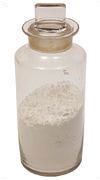Whether you accept it, avoid it or live somewhere in between, insurance coverage has become a defining issue for our profession. Patients increasingly expect to use their benefits, practitioners want to be compensated fairly for their time and expertise, and the system itself remains – at best – fragmented. The encouraging news is that coverage has expanded in meaningful ways. The challenging news is that reimbursement, across the board, remains inadequate.
Vitamins, Minerals and Dietary Supplements
Sodium
What is sodium?
A silvery-white mineral, sodium is one of the most abundant elements in nature. It is usually seen in combination with one or more elements and is chemically very active. About half of the sodium found in the body is in the soft tissues.
Why do we need it?
Sodium plays an essential role in the regulation of blood pressure and blood volume. It also assists with proper muscle contraction and the transmission of nerve impulses. Moderate sodium intake increases resistance to heat cramps and heat stroke, especially during periods of excessive fluid loss through sweating.In addition, manganese plays an important role in the synthesis of cholesterol and fatty acids, and is essential for the utilization of choline, thiamin, biotin, and vitamins C and E. It helps activate enzymes that regulate blood sugar, energy metabolism and function of the thyroid gland.
How much sodium should I take?
According to the National Academy of Sciences, the recommended daily allowance (RDA) for sodium is between 1,100-3,300 milligrams/day.
What are some good sources of sodium?
 Sodium occurs naturally in nearly every food, from milk and beets to celery. It is most readily available in flavorings such as table salt, garlic salt, onion salt and soy sauce. One teaspoon of table salt contains approximately 2,300 milligrams of sodium. Sodium is also added to various food products. Added forms include monosodium glutamate, sodium nitrite, baking soda (sodium bicarbonate) and sodium benzoate. Processed meats such as bacon, sausage and ham, and canned soups and vegetables all contain added sodium. Fast foods are generally very high in sodium.
Sodium occurs naturally in nearly every food, from milk and beets to celery. It is most readily available in flavorings such as table salt, garlic salt, onion salt and soy sauce. One teaspoon of table salt contains approximately 2,300 milligrams of sodium. Sodium is also added to various food products. Added forms include monosodium glutamate, sodium nitrite, baking soda (sodium bicarbonate) and sodium benzoate. Processed meats such as bacon, sausage and ham, and canned soups and vegetables all contain added sodium. Fast foods are generally very high in sodium.
What can happen if I don't get enough sodium?
Sodium deficiency can be attributed to starvation, vomiting, diarrhea, extreme sweating, or any condition with excessive fluid loss. Symptoms of sodium deficiency include intestinal gas, weight loss, short attention span, vomiting, heart palpitations and muscle weakness. Deficiency can cause a buildup of acids in the body, which can lead to arthritis, rheumatism and neuralgia.
What can happen if I take too much?
Excessive sodium intake can cause a loss of potassium in the urine, leading to potassium deficiency. Symptoms of excess sodium include edema, dizziness, and swelling of the legs and face. Excessive salt intake has also been linked to hypertension, and diets high in sodium may increase the likelihood of liver, heart and kidney disease.
References
- Recommended Dietary Allowances, 10th ed. Washington, D.C.: National Academy Press, 1989.
- Beard TC, Blizzard L, OBrien DJ, Dwyer T. Association between blood pressure and dietary factors in the dietary and nutritional survey of British adults. Arch Intern Med 1997;157:234-238.
- Cappuccio FP, Markandu ND, Carney C, Sagnella GA, MacGregor GA. Double-blind randomised trial of modest salt restriction in older people. Lancet Sep 1997;350(9081):850-4.
- Graudal NA, et al. Effects of sodium restriction on blood pressure, renin, aldosterone, catecholamines, cholesterols and triglyceride. JAMA 1998;279:1383-1391.
- Rollnik JD, Mills PJ, Dimsdale JE. Characteristics of individuals who excrete versus retain sodium under stress. J Psychosom Res May 1995;39(4):499-505.
- Carey OJ, Locke C, Cookson JB. Effect of alterations of dietary sodium on the severity of asthma in men. Thorax Jul 1993;48(7):714-8.


